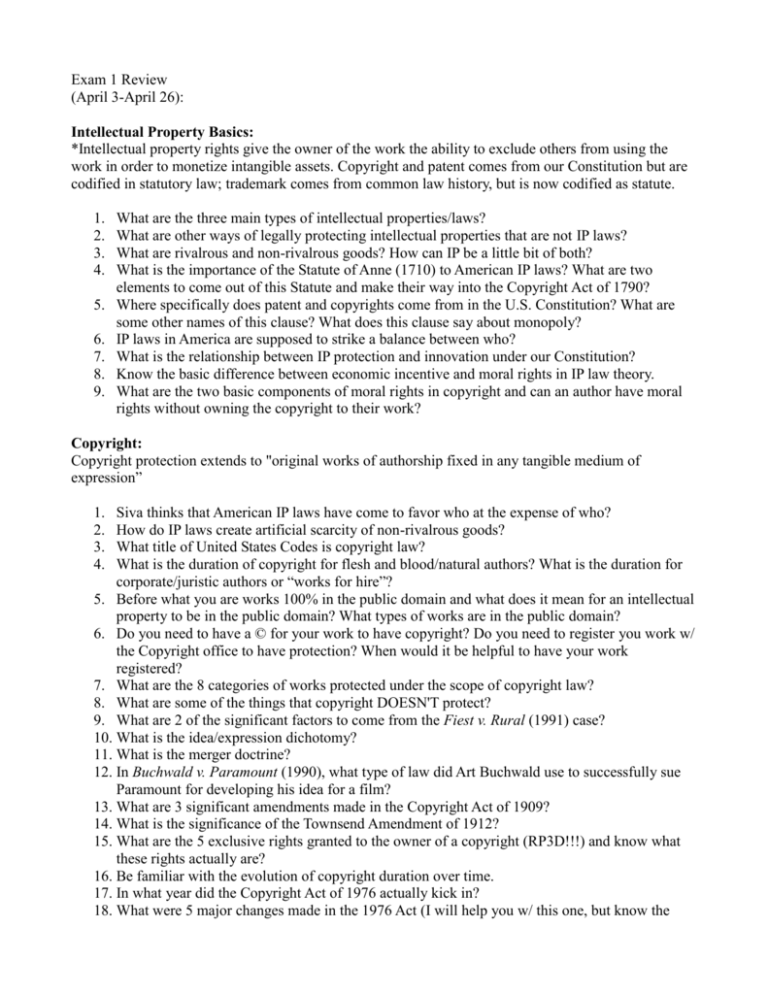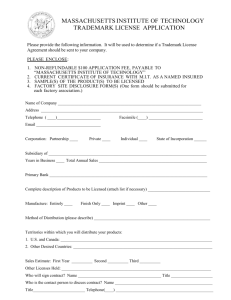Exam #1 Review - WordPress.com
advertisement

Exam 1 Review (April 3-April 26): Intellectual Property Basics: *Intellectual property rights give the owner of the work the ability to exclude others from using the work in order to monetize intangible assets. Copyright and patent comes from our Constitution but are codified in statutory law; trademark comes from common law history, but is now codified as statute. 1. 2. 3. 4. 5. 6. 7. 8. 9. What are the three main types of intellectual properties/laws? What are other ways of legally protecting intellectual properties that are not IP laws? What are rivalrous and non-rivalrous goods? How can IP be a little bit of both? What is the importance of the Statute of Anne (1710) to American IP laws? What are two elements to come out of this Statute and make their way into the Copyright Act of 1790? Where specifically does patent and copyrights come from in the U.S. Constitution? What are some other names of this clause? What does this clause say about monopoly? IP laws in America are supposed to strike a balance between who? What is the relationship between IP protection and innovation under our Constitution? Know the basic difference between economic incentive and moral rights in IP law theory. What are the two basic components of moral rights in copyright and can an author have moral rights without owning the copyright to their work? Copyright: Copyright protection extends to "original works of authorship fixed in any tangible medium of expression” 1. 2. 3. 4. Siva thinks that American IP laws have come to favor who at the expense of who? How do IP laws create artificial scarcity of non-rivalrous goods? What title of United States Codes is copyright law? What is the duration of copyright for flesh and blood/natural authors? What is the duration for corporate/juristic authors or “works for hire”? 5. Before what you are works 100% in the public domain and what does it mean for an intellectual property to be in the public domain? What types of works are in the public domain? 6. Do you need to have a © for your work to have copyright? Do you need to register you work w/ the Copyright office to have protection? When would it be helpful to have your work registered? 7. What are the 8 categories of works protected under the scope of copyright law? 8. What are some of the things that copyright DOESN'T protect? 9. What are 2 of the significant factors to come from the Fiest v. Rural (1991) case? 10. What is the idea/expression dichotomy? 11. What is the merger doctrine? 12. In Buchwald v. Paramount (1990), what type of law did Art Buchwald use to successfully sue Paramount for developing his idea for a film? 13. What are 3 significant amendments made in the Copyright Act of 1909? 14. What is the significance of the Townsend Amendment of 1912? 15. What are the 5 exclusive rights granted to the owner of a copyright (RP3D!!!) and know what these rights actually are? 16. Be familiar with the evolution of copyright duration over time. 17. In what year did the Copyright Act of 1976 actually kick in? 18. What were 5 major changes made in the 1976 Act (I will help you w/ this one, but know the significance)?: codified fair use codified idea/expression dichotomy (both fair use and idea/expression were common law) fix copyright term duration of life+50 or 70 years for corporations (before terms were renewable) you didn't need to register your work w/ the Copyright Office in order to have protection works needed to be fixed in a medium NOT published 19. Under the DMCA (Digital Millennium Copyright Act), what does “safe harbor” mean and how does it apply when YouTube gets sued? 20. In Lenz v. Universal Music Corp (2007), the court ruled that copyright owners that send out a takedown notice under the DMCA must first consider what concept and why do you think in this case they should have? 21. What you should know about the legal concept of fair use: 17 U.S.C. 107 It allows people to use without permission copyrighted works for the purposes of commentary, criticism, education, scholarship/research and news It allows for the parody of copyrighted works To test fair use, courts apply a 4-tiered “balancing test”: ◦ 1). purpose and character of new work (for profit, non commercial) ◦ 2). nature of original work (factual or creative; courts give more protection to creative works) ◦ 3). the amount used (quantity) and the importance to the original (qualitative) ◦ 4). the market harm on the original (this is usually the most important factor) 22. What did the Copyright Term Extension Act of 1998 (CTEA) do and who lobbied for it? 23. Under CTEA, in what year will works start fall into the public domain? (the answer is 2019!) 24. How has Disney profited from the public domain and also limited it? Combined with what you know form above, how does this make so that A Fair(y) Use Tale is still available online (hint: it is parody of Disney's proprietary behavior, it uses very little of each film, nobody would confuse it for a Disney movie, even if Disney wanted to try to take it down how would the baby dancing to a Prince song case play a role?). Trademark: Trademark laws protects any word, name, symbol, or any combination thereof, as representing the source of goods/services. *Please not that trademark laws protect character names, book/film titles, celebrity slogans, etc., which are NOT subject to the scope of copyright. 1. Be familiar with the examples of Air Pirates/Warhol/Mickey Mouse®; Jersery Shore Characters, etc. 2. Think about the numerous reasons why the South Park episode featuring a parody of Mickey Mouse, Disney and the Jonas brothers would not be an infringement on Disney’s trademark/copyrights. 3. What title of U.S. Code does trademark law fall under and what other types of laws/activities are regulated under this code? 4. Under what type of law does trademark have its origins? 5. What are some of the things that trademark law is supposed to prevent? 6. In general, what does Bollier say about trademark laws? 7. What was the first federal trademark act in the U.S.? 8. What are the two ways in which you can get trademark protection? 9. What type of word should a trademark be and what types of words should you avoid? Think of examples! 10. What is the duration/term of protection for trademarks that are federally registered? 11. What are the 3 ways that you can lose trademark protection.? 12. How many years of non-use does it take for your trademark to be considered abandoned? 13. What does trademark genericization/genercitity mean, and what are examples of marks that have become generic? 14. While the Lanham Act of 1946 is our primary federal statue, what very important test came out of this Act and what does this test consider? 15. Under the Federal Trademark Dilution Act of 1995, what types of trademark holders had the right to silence critics as long as they prove _______________? 16. What act amended the Dilution Act of 1995 and what was the major revision? This revision was likely due to what? 17. What is the difference between ®, ™, and ℠? 18. What are some examples of ℠? 19. What types of marks are considered unconventional marks? 20. What are some examples of famous sound marks? 21. What are some examples of “trade dress” and what DOESN’T trade dress protect in a good? 22. What is the KEY element in trademark protection and maintaining protection of a mark? 23. Be able to define and thus consider examples of: 1. Fanciful marks: 2. Arbitrary marks: 3. Suggestive marks: 4. Descriptive marks: 5. Generic marks: 24. What are some marks/brands that have faced becoming generic; what do these companies do to avoid genericity (hint: advertise and market using the brand name as an adverb. I.e. Band-Aid bandages or Kleenex facial tissues)? 25. Some things to consider from Dyste’s talk: 1. UO has exclusive license w/ Nike for the use of O on apparel/headwear…what does this “exclusive license” mean. 2. What is the University of Oregon’s most valuable mark? What type of mark is it? 3. Think, in depth, about the “I Love My Ducks” situation. Why couldn’t Supwitchugirl get federal protection? 26. What does territoriality refer to in trademark protection? 27. What does the Anti-Cybersquatting Consumer Protection Act of 1999 prevent? 28. What is trademark dilution? What is the difference between blurring and tarnishing marks and what are examples of both? 29. What were some of the reasons by Dwyer's Starbucks parody (consumer whore) likely not a fair use? 30. What was the significance of the Victor's Little Secret v. Victoria's Secret ruling? And, because of what amendment is this a moot point? 31. Based upon what you know about famous marks, why would Ari's “Menthol 10” sneakers not be considered fair use?




